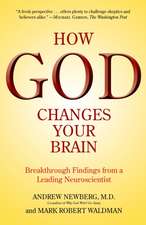Statistical Methods for Modeling Human Dynamics: An Interdisciplinary Dialogue: Notre Dame Series on Quantitative Methodology
Editat de Sy-Miin Chow, Emilio Ferrer, Fushing Hsiehen Limba Engleză Hardback – 9 dec 2009
Readers will appreciate a review of the latest methodological techniques developed in the last few years. Highlights include an examination of:
- Statistical and mathematical modeling techniques for the analysis of brain imaging such as EEGs, fMRIs, and other neuroscience data
- Dynamic modeling techniques for intensive repeated measurement data
- Panel modeling techniques for fewer time points data
- State-space modeling techniques for psychological data
- Techniques used to analyze reaction time data.
Preț: 857.21 lei
Preț vechi: 1146.02 lei
-25% Nou
Puncte Express: 1286
Preț estimativ în valută:
164.05€ • 178.13$ • 137.80£
164.05€ • 178.13$ • 137.80£
Carte tipărită la comandă
Livrare economică 22 aprilie-06 mai
Preluare comenzi: 021 569.72.76
Specificații
ISBN-13: 9781848728257
ISBN-10: 1848728255
Pagini: 444
Dimensiuni: 152 x 229 x 28 mm
Greutate: 0.98 kg
Ediția:1
Editura: Taylor & Francis
Colecția Routledge
Seria Notre Dame Series on Quantitative Methodology
Locul publicării:Oxford, United Kingdom
ISBN-10: 1848728255
Pagini: 444
Dimensiuni: 152 x 229 x 28 mm
Greutate: 0.98 kg
Ediția:1
Editura: Taylor & Francis
Colecția Routledge
Seria Notre Dame Series on Quantitative Methodology
Locul publicării:Oxford, United Kingdom
Cuprins
Introduction and Section Overview. Part 1. Parametric and Exploratory Approaches for Extracting Within-Person Nonstationarities. P.C.M. Molenaar, N. Ram, Dynamic Modeling and Optimal Control of Intra-Individual Variation: A Computational Paradigm for Non-Ergodic Psychological Processes. M. Tarvainen, Dynamic Spectral Analysis of Biomedical Signals with Application to EEG and Heart Rate Variability. B. Gao, H. Ombao, M.R. Ho, Cluster Analysis for Non-Stationary Time Series. R. Prado, Characterizing Latent Structure in Brain Signals. H. Ombao, R. Prado, A Closer Look at Two Approaches for Analysis and Classification of Non-Stationary Time Series. Part 2. Representing and Extracting Intraindividual Change. S. Boker, P.R. Deboeck, C. Edler, P. Keep, Generalized Local Linear Approximation of Derivatives from Time Series. P.R. Doebeck, S.M. Boker, Unbiased, Smoothing-Corrected Estimation of Oscillators in Psychology. P.F. Craigmile, M. Peruggia, T. Van Zandt, Detrending Response Times Series. G. Zhang, M.W. Browne, Dynamic Factor Analysis with Ordinal Manifest Variables. R.P. Bowles, Measuring Intraindividual Variability with Intratask Change Using Item Response Models. Part 3. Modeling Interindividual Differences in Chang and Interpersonal Dynamics. R. Cudeck, J. Harring, Developing a Random Coefficient Model for Nonlinear Repeated Measures Data. F. Hamagami, Z.J. Zhang, J. McArdle, A Bayesian Discrete Dynamic System by Latent Difference Score Structural Equations Models for Multivariate Repeated Measures Data. L. Wang, Z. Zhang, R. Estabrook, Longitudinal Mediation Analysis of Training Intervention Effects. F. Hsieh, S. Chen, S. Chow, E. Ferrer, Exploring Intra-Individual, Inter-Individual and Inter-Variable Dynamics in Dyadic Interactions.
Recenzii
"This is a timely and important book that addresses an integrated set of topics that will be of great interest to a broad audience of researchers studying human dynamics. The contributors are among the leaders in their respective fields and jointly represent a truly interdisciplinary perspective on these issues. The material is presented in both an accessible and technically rigorous manner, and real data examples help clarify key points throughout. Importantly, this text offers a collection of papers that challenge many traditional beliefs held about the "typical" analysis of repeated measures data. I recommend this book highly." - Patrick J. Curran, University of North Carolina, Chapel Hill, USA
"Dynamical modeling of intraindividual change and variability obtained from many sources and in a wide range of time scales is the promising future of behavioral science research and the availability of this outstanding volume will accelerate our progress in that direction. Take it home, take it to the office, take it to class and, whatever you do, take it seriously!" - John R. Nesselroade, University of Virginia, USA
"Intensive longitudinal designs will be providing cutting edge insights into psychological, neuroscience and biomedical processes during the next decades, and researchers using these designs will want to study the useful approaches described in this volume. I consider this book to be required reading!" - Patrick E. Shrout, New York University, USA
"I am delighted to see this outstanding volume containing contributions connecting mathematics, classical and Bayesian statistics, signal processing and psychology. .. Other subject matter areas could well take this volume as a model for presenting the results of collaborative research in their own fields."-Robert H. Shumway, University of California, Davis, USA
"Dynamical modeling of intraindividual change and variability obtained from many sources and in a wide range of time scales is the promising future of behavioral science research and the availability of this outstanding volume will accelerate our progress in that direction. Take it home, take it to the office, take it to class and, whatever you do, take it seriously!" - John R. Nesselroade, University of Virginia, USA
"Intensive longitudinal designs will be providing cutting edge insights into psychological, neuroscience and biomedical processes during the next decades, and researchers using these designs will want to study the useful approaches described in this volume. I consider this book to be required reading!" - Patrick E. Shrout, New York University, USA
"I am delighted to see this outstanding volume containing contributions connecting mathematics, classical and Bayesian statistics, signal processing and psychology. .. Other subject matter areas could well take this volume as a model for presenting the results of collaborative research in their own fields."-Robert H. Shumway, University of California, Davis, USA











